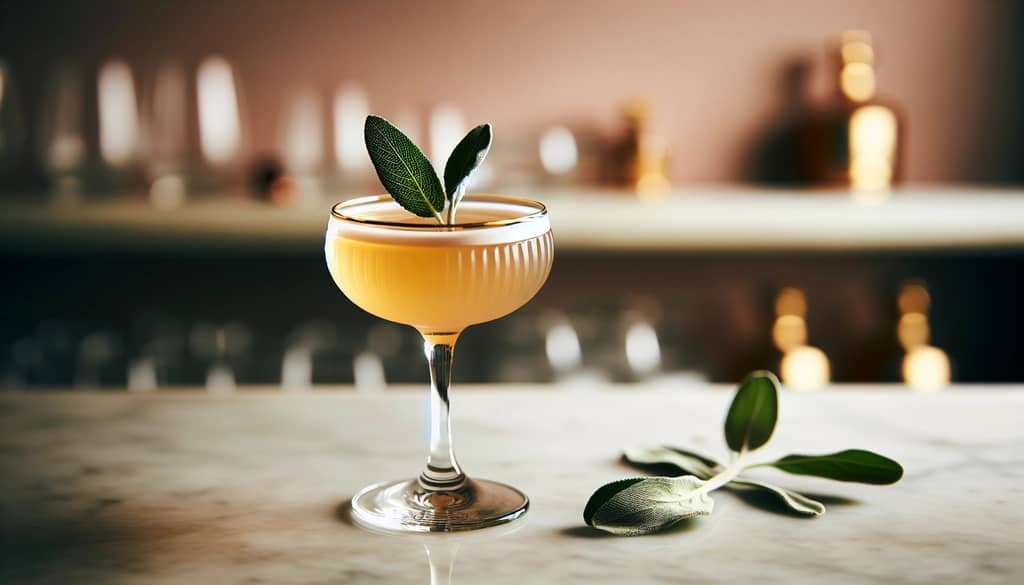Updated on: 6/3/2025
Sage Bee's Knees Cocktail: Recipe, Sage Syrup, and Herb Mixology

The Sage Bee's Knees transforms the 1920s classic gin cocktail with the herbal depth of fresh sage. By pairing honey syrup’s comforting sweetness with the aromatic, almost piney notes of sage, this variation adds nuance and complexity without complicating the beloved foundation. It’s a favorite among bartenders and adventurous home enthusiasts who enjoy herbs in their drinks.
What Makes a Sage Bee's Knees Unique?
At its core, a Bee's Knees mixes gin, lemon juice, and honey syrup. Infusing the honey with sage or using a fresh sage garnish unlocks more botanical character—earthy yet citrus-forward, bridging the gin’s botanicals and honey’s florality. Sage provides gentle complexity rather than overwhelming the palate. The result: a crisp, slightly savory cocktail perfect for late spring through autumn.
Classic Sage Bee's Knees Recipe
- 60 ml dry gin (a classic or botanically forward style; avoid syrupy or sweet gins)
- 22.5 ml fresh lemon juice (strained)
- 22.5 ml sage honey syrup (see below)
- 1 fresh sage leaf (for garnish)
- Add gin, lemon juice, and sage honey syrup to a shaker filled with ice.
- Shake vigorously for 12–15 seconds until chilled and slightly frothy.
- Double strain into a chilled coupe glass.
- Gently clap sage leaf to release oils and float on top as garnish.
How to Make Sage Honey Syrup
Sage syrup adds complexity and aroma to cocktails, especially when working with gin, whiskey, or even tequila. Its preparation is quick and extends well to other herb-infused syrups:
- Combine 60 ml honey and 60 ml water in a small saucepan.
- Warm over low heat, stirring until honey is dissolved (do not boil).
- Add 4–5 fresh sage leaves. Simmer gently for 3–5 minutes until aromatic.
- Remove from heat. Let steep for 15–20 minutes, tasting for intensity.
- Strain out sage leaves and cool before using. Store sealed and refrigerated for up to 2 weeks.

Tips for Using Fresh Herbs in Cocktails
Contemporary mixology relies on more than citrus and bitters. Fresh sage, thyme, rosemary, mint, and basil can spotlight or contrast with spirits, syrups, and juices. A few fundamentals help balance flavor and aroma without turning drinks aggressive or vegetal:
- Always use fresh herbs—dry versions lack the needed volatile oils.
- For syrups, gently heat and steep: avoid boiling, which destroys aroma.
- For cocktails, express essential oils by clapping or slapping the herb (not muddling to a pulp).
- Start small—herbal flavors amplify after steeping or shaking. Taste and adjust.
- Pair earthier herbs like sage or thyme with honey, grapefruit, or aged spirits; pair brighter herbs like mint or basil with citrus and lighter spirits.

Sage Pairings and Experimentation
Beyond the Bee's Knees, try sage syrup with different base spirits or citrus. It matches well with smoky mezcal, peppery rye, or even apple-based brandies. Grapefruit, pear, or orange provide interesting options beyond lemon. Pair with bitters (orange, cardamom, or lavender work well) for extra aroma. Combining several fresh herbs in a syrup can create distinctive house signatures for the home bartender or cocktail bar.